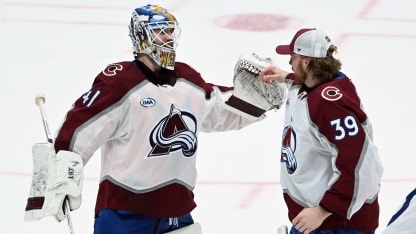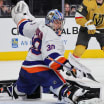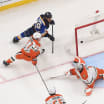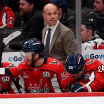VANCOUVER -- When it comes to making a goalie change, the NHL Trade Deadline is too often too late in the season, and at least one team appears to have figured that out.
The Colorado Avalanche performed a wholesale makeover of their crease, first acquiring Scott Wedgewood from the Nashville Predators for backup Justus Annunen and a sixth-round pick in the 2025 NHL Draft on Nov. 30, then swapping starters with the San Jose Sharks by trading Alexandar Georgiev for Mackenzie Blackwood as part of a Dec. 9 deal that included four players and three draft picks.
The moves have paid off for Colorado, with Blackwood going 7-1-1 with a .938 save percentage since arriving after starting the season 6-9-3 with a .911 save percentage in San Jose, and Wedgwood 4-2-0 with a .917 save percentage for the Avalanche after starting 1-2-1 with an .878 save percentage in Nashville.
Blackwood, who signed a five-year contract with Colorado on Dec. 28, said he believes the adjustment has been easier, at least in part, because the trade happened earlier.
“I feel that’s definitely more of a challenge,” Blackwood said of goalies changing teams closer to the NHL Trade Deadline, which is March 7 this season, “Especially because you’re at the end of the year and everyone is fighting for playoff spots. You get put into a situation that’s very tense and stuff like that and you’re having to deal with moving and all that. … If you’re going to get moved, I feel this was a bit of an easier time to do it. It gives you more time.”
There are, of course, a lot of other factors that go into a goalie being able to adjust to a new team after being traded. The first Blackwood pointed to was how good the Avalanche are in front of him; that he has played so well so soon after his first in-season trade may seem to run contrary to the idea a goalie needs more time to get comfortable, most agree with his premise about the trade deadline often not leaving enough time for goalies to get settled.
“Especially at that point of the season,” said Ottawa Senators No. 1 Linus Ullmark, who is on his third NHL team but moved during the offseason each time. “You play for with a team for that long, you are just so used to all the tendencies, and now you’ve got to switch, and now you have to start all over again.”
A big part of goaltending is being able to read plays and anticipate what might be coming next, and while a lot of that comes from what the attacking team is doing, some is an understanding of how teammates defend. Changing teams means an adjustment to a new defensive system and the individual tendencies of teammates within that structure.
“I would say that it’s more systems in-zone but off the rush it's more tendencies,” Ullmark said. “Do you have a guy that likes to kill the play early, surf over, gap up, or is it more of a defensive approach and just playing stick on puck, enabling them to kind of gain the zone?
"That's something you get to know as you play more and more games seeing these tendencies. What does this guy usually like to do when the puck gets rimmed around? Is he a guy that holds onto the puck at all times trying to make a good play? Or is he more of a chip-it-out kind of guy?”
Systems tend to be relatively quick for goalies to figure out, but some say getting fully comfortable with all of those individual inclinations of new teammates can take half a season, depending on how well the team is playing. Because most teams typically have at most 20 games left in their season following the trade deadline and most goalies are unlikely to start more than 15, it’s little wonder that goalie trades aren’t typically a big part of the annual talent swap.
“It takes time knowing some guys want to block more shots, and some guys use more stick, and some guys go down,” said Boston Bruins goalie Joonas Korpisalo, who was traded to the Los Angeles Kings from the Columbus Blue Jackets at the 2023 deadline. “Just reading off each other, that takes time, for sure.”
Like Blackwood and Wedgewood in Colorado, Korpisalo appeared to adjust quickly in Los Angeles, going 7-3-1 with a .921 save percentage after going 11-11-3 with a .913 save percentage in Columbus. And like Blackwood, Korpisalo pointed to the defensive structure.
“It was predictable,” he said. “We played 1-3-1, which is in my eyes a really good, simple way to play, just knowing there's always that one guy really low and playing the puck, you just leave the puck because he's going to be first every time.”
Blackwood spoke about the Avalanche being predictable defensively.
“It’s the same game, they just play a different style,” he said. “The coverage is different and what they give up is a lot different. Playing here, they do a really good job of sheltering you, so you don’t get bombarded with Grade-A chances all night, so it makes your job a lot easier. They do a really good job of that.”
There are, however, other factors that can affect how quickly a goalie adjusts.
Ullmark pointed to family life and whether a goalie has young children they may have to leave behind or pull out of school, and how even simple things like a significant change in how long it takes to drive to the rink can change pregame and prepractice routines that have varying importance to different goalies.
Familiarity with the process, and whether a goalie has been through a move before, even in the offseason, can also impact the time it takes to adjust.
Even going to a better defensive team can present unique challenges. It might seem like fewer shots would make life easier, but some goalies can struggle when they aren't busy. That’s part of Blackwood’s adjustment in Colorado.
“They possess the puck a lot more, so we spend way less time in our end,” he said. “In one way, it’s more challenging because you don’t have constant shots, so it’s harder to maybe stay in the game mentally, but the chances you’re getting are less and fewer and far between. It’s easier in one way and different in another.”
Fortunately for Blackwood, he has plenty of time to get used to it.
“I don’t have anything to compare it to, but I would say more time helps.”
NHL.com staff writer Tracey Myers contributed to this report.


















